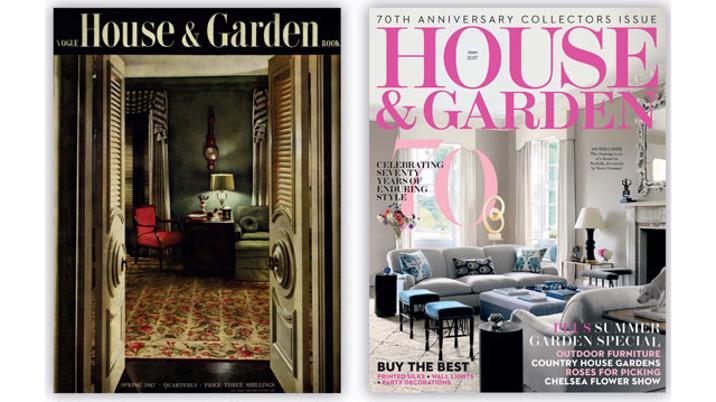
House & Garden editor Hatta Byng’s outer office in Vogue House is a casebook study in understated style, with an entire wall of bookshelves lined with dark blue bound editions of past issues of the magazine. The Condé Nast title turns 70 this year, but far from having resigned itself to a graceful dotage, it has embraced the digital age with passion, with a successful website and a lively social media presence, as well as a bigger than ever House & Garden Festival to mark the anniversary this summer.
Byng shows me the editor’s letter introducing the first ever edition of the quarterly Vogue House & Garden Book launched in 1947 in the aftermath of the Second World War. “Now, phoenix-like from the ashes of war, the arts of peace are struggling to rise again. Men and women are once more dedicating their minds and their energies to creation and to rebuilding. What could be better or more natural than that they should turn first to their houses and to their gardens?”
Seven decades later, the House & Garden Instagram feed contains beautiful images of rooms and outdoor spaces created by contemporary designers, while the House website at HouseandGarden.co.uk features inspirational galleries ranging from ‘Artists’ Homes’ to ‘City Gardens’, as well as articles from the magazine’s rich archive such as ‘Italian Cooking with Elsa Schiaparelli’ from 1957 or ‘David Hockney’s Flat’ from 1969.
Launched in 2014, the website now boasts around a million users and 5.3m page impressions a month. “We have all this archivable imagery, so we can create galleries that are very useful for people doing up their house. It was a natural progression and there was immediately a huge appetite for it,” explains Byng.
Publisher Kate Slesinger adds: “I don’t think anyone could have predicted how successful it would be. We exceeded the annual target within six months in terms of users and page views. We’re hugely right for an era where people consume House & Garden on many different platforms.”
The three-person online team punches above its weight, with 307,000 followers on Instagram and 153,000 on Twitter, as well as 6.1m likes on Facebook and 80,000 Pinterest followers. Byng praises online editor Emily Senior for “thinking pretty creatively” to keep the brand’s social media presence relevant and interesting, for example by asking different designers to ‘takeover’ the Instagram account for a day at a time.
The brand’s digital offerings attract a slightly younger audience with a better female / male balance. “The magazine has such a strong and loyal subscriber base and they are a slightly different reader to the person going online to look at the galleries and find inspiration for their builder to put up a bookcase,” says Byng.
Unashamedly upmarket
This loyal subscriber base has remained practically unchanged since Slesinger became publisher seven years ago, at around 37,000 out of a total circulation of 113,000. The readers are incredibly affluent, with an average household income of £141,379 and a home worth on average £930,897. Their loyalty is demonstrated by the fact that 50% of House & Garden readers don’t read any other upmarket home-interest title. “We are very proud of our subscribers. They provide endless sources of opinion. There’s no question that print is first and foremost, the heart of House & Garden,” says Slesinger.
She adds: “I think the digital has just evolved and grown organically to complement it in a lovely way. It’s amazing that we’ve accomplished so much with digital in such a relatively short time, to get to this point where we are now 70 and we have all these digital users and a very strong print circulation and subscriber base. In this day and age, where magazines are toppling left, right and centre, I think we’re doing really well.”
Travel is a very important aspect of the lives of House & Garden readers who have a median age of 51 and are likely to own their own home, as well as possibly a second and third property, and whose children have often flown the nest. The title produces two travel-related supplements - House & Garden Destinations in January and Hotels by Design in May, as well as special sections on villas, family travel, spas and wellness and cruises.
Slesinger reveals: “81 per cent of our readers don’t read any other upmarket woman’s title. So, it’s very low duplication. From an advertisers’ point of view, faced with that piece of information, why would you not advertise in House & Garden? Because you can reach really affluent consumers who have the time, money and inclination to spend and who have the right mindset, appreciate good taste, good style and who love travel.”
A trade element
One of the things of which Byng is proudest is the high percentage of House & Garden readers who work in a related field - with the latest figure for trade readership standing at 95,540. “What marks us out from our competitors is that we are so strongly read by the industry and used as a guide and a bible to find their sources, whether it be a specialist painter or a lamp. In my head, I’m always thinking about the person with the old rectory in the country, the person with the London flat and then the industry helping these people,” she says.
December 2017 will see the first print supplement edition of The List, an online sourcebook for designers and craftspeople which is searchable by location. Slesinger explains: “We launched it last February with the aim of providing an answer to that perennial question, ‘Do you know someone who can…?’ make curtains, decorate my children’s room, do my kitchen, whatever. It was the brainwave of Nicholas Coleridge (chairman of Condé Nast UK) who thought it would be fantastic to have a directory that was searchable by profession and by geographical location. So, if you live in the Cotswolds and you want someone to decorate your sitting room, you go onto the list, you go into the Cotswolds and you find a whole range of decorators who have been vetted by House & Garden and who have admittedly paid a small subscription fee.” The target was to have 500 professionals signed up by the end of 2016 and in fact they had 650, a number which now stands at around 800 and rising. As well as providing a useful service to readers, The List operates as a community for these professionals, with regular networking events.
The magazine has run the Spirit of Summer Fair for some years, but to mark its 70th anniversary, it is hosting a bigger than ever before House & Garden Festival at London’s Olympia in June, incorporating for the first time the contemporary garden fair, Grow London. “We expect more visitors and we have more exhibitors than ever. There are talks and workshops and we’re all involved. We also have two what we call ‘decorated spaces’. Each year we ask designers to come up with schemes and this year, they’re pretty punchy,” enthuses Byng.
There is also a bumper birthday issue with a 30-page extra editorial section on the A to Z of House & Garden - “It’s lighthearted and fun and it’s been a real winner with the advertisers,” says Byng, who insists: “We’re not feeling like this could be the last hurrah. There’s a feeling of sending it forward.”
Retail opportunities
Last year, House & Garden made a brief foray into retail with a pop-up shop in Bloomsbury. Byng explains that the shop arose ‘organically’ when the design store Pentreath & Hall offered to waive the rent. “We thought it would be fun to try it out and see what appetite there was for our curated selection of things. It wasn’t at all strategic or thought through, as long as we broke even. It’s probably something we would consider again, but in a bigger, more formal way and more planned.”
Slesinger adds: “We learnt that retail is a whole different world; there are lots of spreadsheets going on. The other thing we learnt was that when we sprinkle that House & Garden fairy dust on things, people want to buy them, they go out of their way.” With this in mind, the magazine is working on launching a House & Garden-branded range of products with a retail partner later this year, although the project is currently being kept closely under wraps.
The next step for the magazine is to build a mobile-friendly version of the website. They are currently waiting in a queue behind other Condé Nast titles. “As soon as we’ve got the go-ahead for that, we will put new energy into what it looks like. Google prioritises mobile-friendly websites, so at the moment we are at a slight disadvantage, but doing pretty well considering,” says Byng.
Above all, integrity is what matters to the House & Garden team and the magazine’s editor, who reveals: “I am pretty adamant that the houses we are showing shouldn’t have been published anywhere else in the world. We sometimes make exceptions, but once it’s in an English-speaking magazine, then they are on Instagram, they are out there, so exclusivity is becoming more and more important. We also feel very much that each house - whether it’s a little country cottage and decorated quite simply or whether it’s a quite amazingly decorated house in Mayfair - needs to be a really good example of its kind. It’s not about the money spent, it’s about the integrity of the interiors.”
As the first editor, Antony Hunt, concluded in 1947: “We hope and believe that in the future there will still be an ‘overwhelming minority’ who count gracious houses and lovely gardens among their most precious possessions. To help achieve this is the object of Vogue House & Garden Book.”










